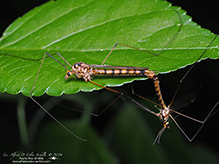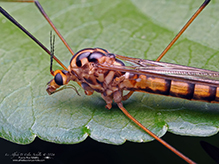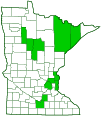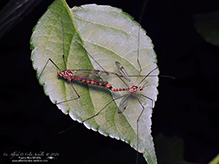tiger crane fly
(Nephrotoma alterna)
Conservation • Description • Habitat • Ecology • Distribution • Taxonomy
|
|
||||||||||||||
Description |
Nephrotoma alterna is a small tiger crane fly. It occurs in the United States from Maine to northern Florida, west to South Dakota and Colorado. It also occurs in southern Canada from Nova Scotia to Manitoba. Adults are seen from early May through late August, but there is a clear peak in late June to early July. They are active at night (nocturnal) and at dusk and dawn (crepuscular). They are found at the edges of deciduous forests and in moist to wet areas near lakes, ponds, rivers, and streams. The female body length is 11⁄16″ to ¾″ (18 to 20 mm). The male is much smaller, with a body length of 7⁄16″ to 9⁄16″ (11 to 14 mm). The head is mostly pale yellow to yellow. The top of the head (vertex) is brownish yellow, the area between the eyes is brown, and a broad mark on the back of the head (occiput) is dark brown to black. The snout (rostrum) is short and has a beak-like point. The upper (dorsal) part of the rostrum is brown to dark brown. The lower jaws (maxillae) have sensory structures (palpi) attached. The last segment of each palp is antenna-like and very long, much longer than the subapical segment. There are two large, black, compound eyes and no simple eyes (ocelli). The antennae have 13 segments. The first segment (scape) is yellow, and on the male, it is tinted with brownish black above. The second segment (pedicel) is short and light brown to dark brown. The remaining segments are dark brown to black. The thorax is yellow with dark markings. The markings are usually dark brown to black, but they may be much lighter. The main exoskeletal plates on the upper side are, from front to back, the pronotum, scutum 1 (also called , scutum 2, and the scutellum. The pronotum is small and collar-like. It is yellow above and dark on the sides. Scutum 1 is the largest plate. It has three broad, dark, longitudinal stripes. The lateral stripes are distinctly curved downward at the front. A distinct, V-shaped groove (transverse suture) on top near the wing bases separates scutum 1 and scutum 2. There is a black spot at each end of the transverse suture. The front side corners of scutum 2 are dark. The scutellum is small and dark. The abdomen is long, slender, and pale yellow to brownish yellow, with variable brown to black (dark) markings. On the male, the first abdominal segment (tergite 1) is usually dark above, light on the sides. Tergites 2 through 5 or 6 have dark, forward pointing, more or less triangular markings on the rear three-fourths to four-fifths. Tergite 7 may be entirely dark or dark only at the rear. Tergite 8 is entirely dark. On the female, the markings on tergites 2 through 7 are usually much smaller, on only one third to one fourth of each tergite. The legs are stilt-like, very long, very slender, and very fragile, easily separated from the body. On each leg, the third segment (femur) is light brown, dark just at the tip; the fourth segment (tibia) is light brown to brown, dark just at the tip; and the last part of the leg (tarsus) is dark brown. The wings are very long, very narrow, and mostly clear. On each wing, the tip is tinged with black, and the pterostigma is dark brown. There is a distinct dark seam across each wing along the basal part of the R4+5 vein and the r-m cross vein. The seam is less distinct along the m-cu vein, M4 vein, and the end of the CU vein. Each wing has two anal veins that meet the inner margin. |
Size |
Female body length: 11⁄16″ to ¾″ (18 to 20 mm) Male body length: 7⁄16″ to 9⁄16″ (11 to 14 mm) |
Similar Species |
Habitat |
Edges of deciduous forests; moist to wet areas near lakes, ponds, rivers, and streams |
Ecology |
Season |
Early May through late August |
Behavior |
|
Life Cycle |
|
Larva Food |
|
Adult Food |
|
Distribution |
||
|
Sources Oosterbroek P. (1984) A revision of the crane-fly genus Nephrotoma Meigen, 1803, in North America (Diptera, Tipulidae). Part II. The non-dorsalis species-groups. Beaufortia 34: 117‒180. |
|
| 6/20/2025 | ||
Occurrence |
||
|
||
Taxonomy |
|
Order |
|
Suborder |
Nematocera |
Infraorder |
|
Superfamily |
Tipuloidea (typical crane flies) |
Family |
|
Subfamily |
|
Genus |
Nephrotoma (tiger crane flies) |
Attempts to segregate the subfamily Tipulinae into tribes has been unsuccessful due to the near constant addition of new species and genera. |
|
Subordinate Taxa |
|
|
|
Synonyms |
|
Nephrotoma evasa Nephrotoma incurva Nephrotoma montana Nephrotoma nexilis Nephrotoma perdita Pachyrhina evasa Pachyrhina incurva Pachyrhina montana Pachyrhina nexilis Pachyrhina perdita Pachyrrhina incurva Tipula alterna |
|
Common Names |
|
This species has no common name. The common name of the genus Nephrotoma is tiger crane flies, and it is applied here for convenience. |
|
Glossary
Femur
On insects and arachnids, the third, largest, most robust segment of the leg, coming immediately before the tibia. On humans, the thigh bone.
Occiput
The back of the head. In Odonata, Megaloptera, and Neuroptera, the upper part of the head behind the eyes.
Ocellus
Simple eye; an eye with a single lens. Plural: ocelli.
Palp
Short for pedipalp. A segmented, finger-like process of an arthropod; one is attached to each maxilla and two are attached to the labium. They function as sense organs in spiders and insects, and as weapons in scorpions. Plural: palpi or palps.
Pedicel
On plants: the stalk of a single flower in a cluster of flowers. On insects: the second segment of the antennae. On Hymenoptera and Araneae: the narrow stalk connecting the thorax to the abdomen: the preferred term is petiole.
Pterostigma
The dark, blood-filled second cell at the leading edge of each wing toward the tip on many insects. It is heaver than adjacent, similar sized areas and is thought to dampen wing vibrations and signal mates. (= stigma. More precise than stigma but less often used, even by entomologists.)
Rostrum
The stiff, beak-like projection of the carapace or prolongation of the head of an insect, crustacean, or cetacean.
Scape
In plants: An erect, leafless stalk growing from the rootstock and supporting a flower or a flower cluster. In insects: The basal segment of the antenna.
Scutum
The forward (anterior) portion of the middle segment of the thorax (mesonotum) in insects and some arachnids.
Tarsus
On insects, the last two to five subdivisions of the leg, attached to the tibia; the foot. On spiders, the last segment of the leg. Plural: tarsi.
Tergite
The upper (dorsal), hardened plate on a segment of the thorax or abdomen of an arthropod or myriapod.
Tibia
The fourth segment of an insect leg, after the femur and before the tarsus (foot). The fifth segment of a spider leg or palp. Plural: tibiae.
Vertex
The upper surface of an insect’s head.
Visitor Photos |
||
Share your photo of this insect. |
||
This button not working for you? |
||
Luciearl |
 |
Crane on glass table. |
Alfredo Colon |
||
 |
 |
|
 |
 |
|
 |
||
MinnesotaSeasons.com Photos |
||
|
||
|
||

Slideshows |
|

Visitor Videos |
||
Share your video of this insect. |
||
This button not working for you? |
||
|
Other Videos |
||
Mating Of Large Crane Flies(🆔Nephrotoma Alterna) |
About
Apr 17, 2024 |

Visitor Sightings |
||
Report a sighting of this insect. |
||
This button not working for you? |
||
Luciearl |
Location: Lake Shore, MN Crane on glass table. |
 |
Alfredo Colon |
Location: Albany, NY |
 |
Alfredo Colon |
Location: Albany, NY |
 |
Alfredo Colon |
Location: Woodbury, MN |
 |
MinnesotaSeasons.com Sightings |
||
|

|
Created: 9/21/2024 Last Updated: © MinnesotaSeasons.com. All rights reserved. |

